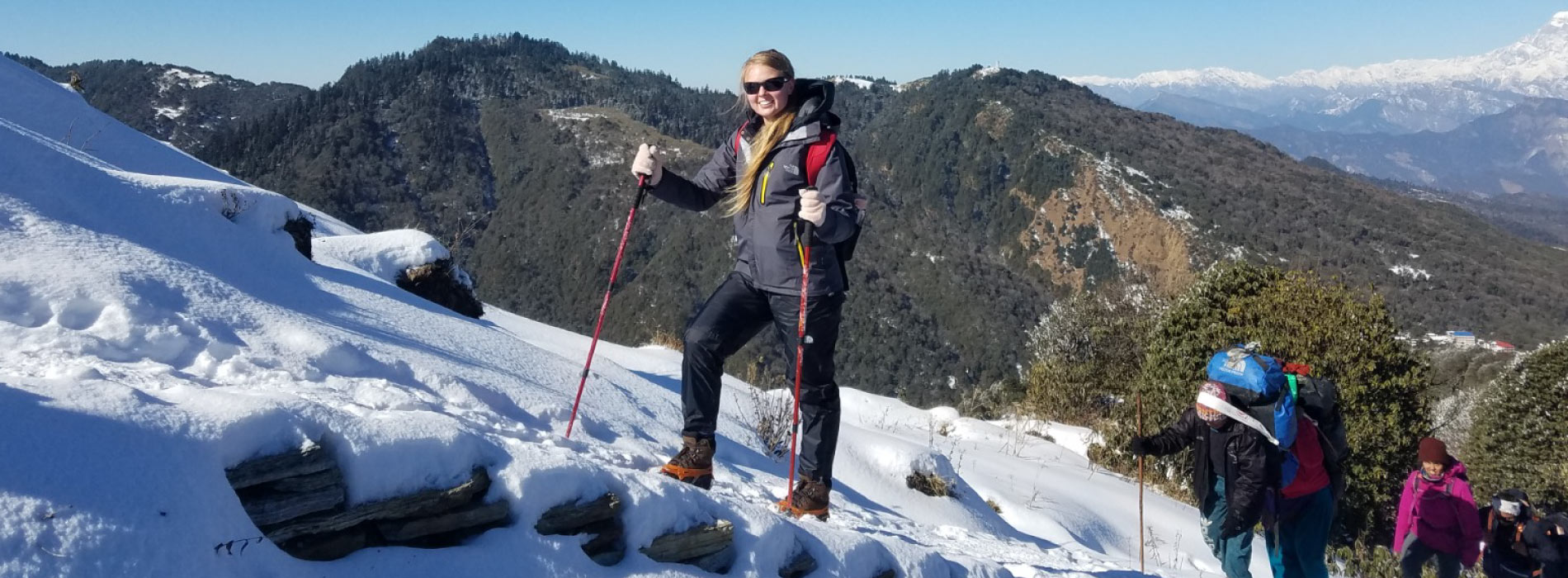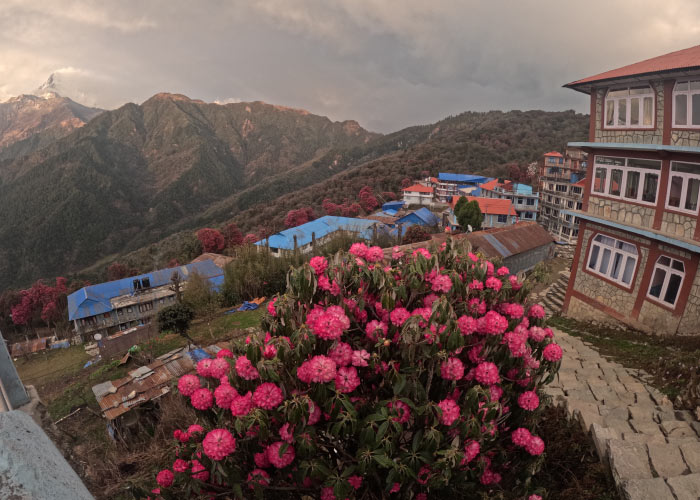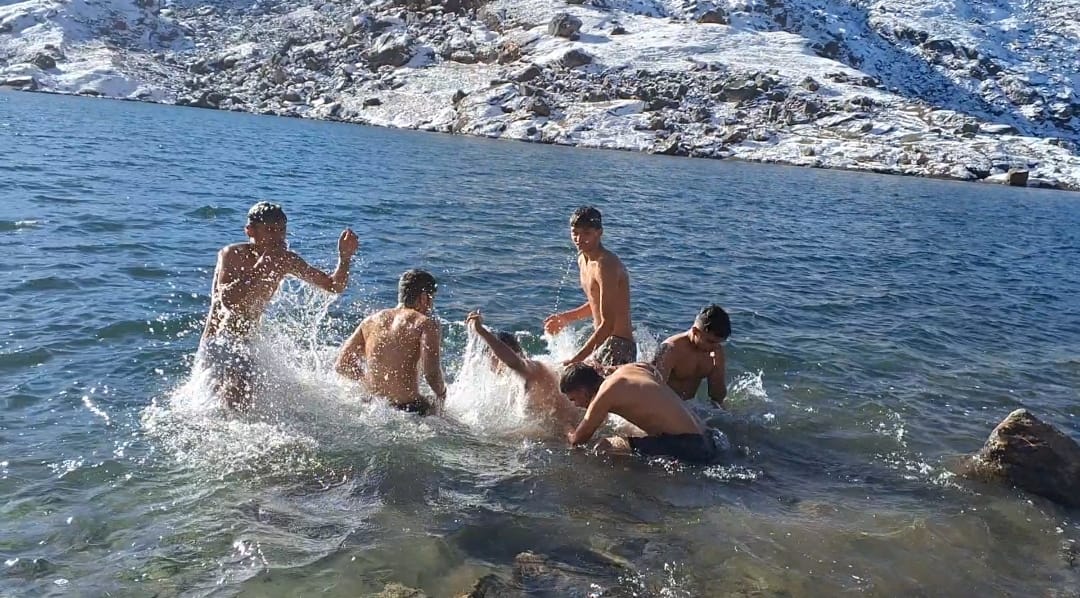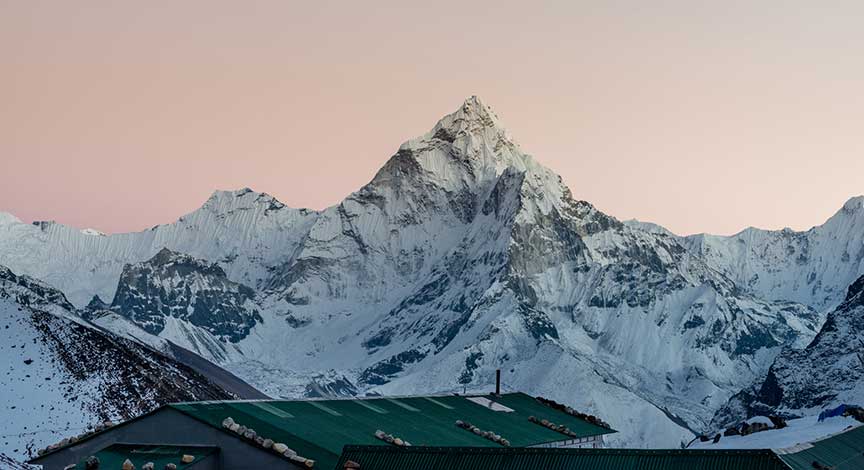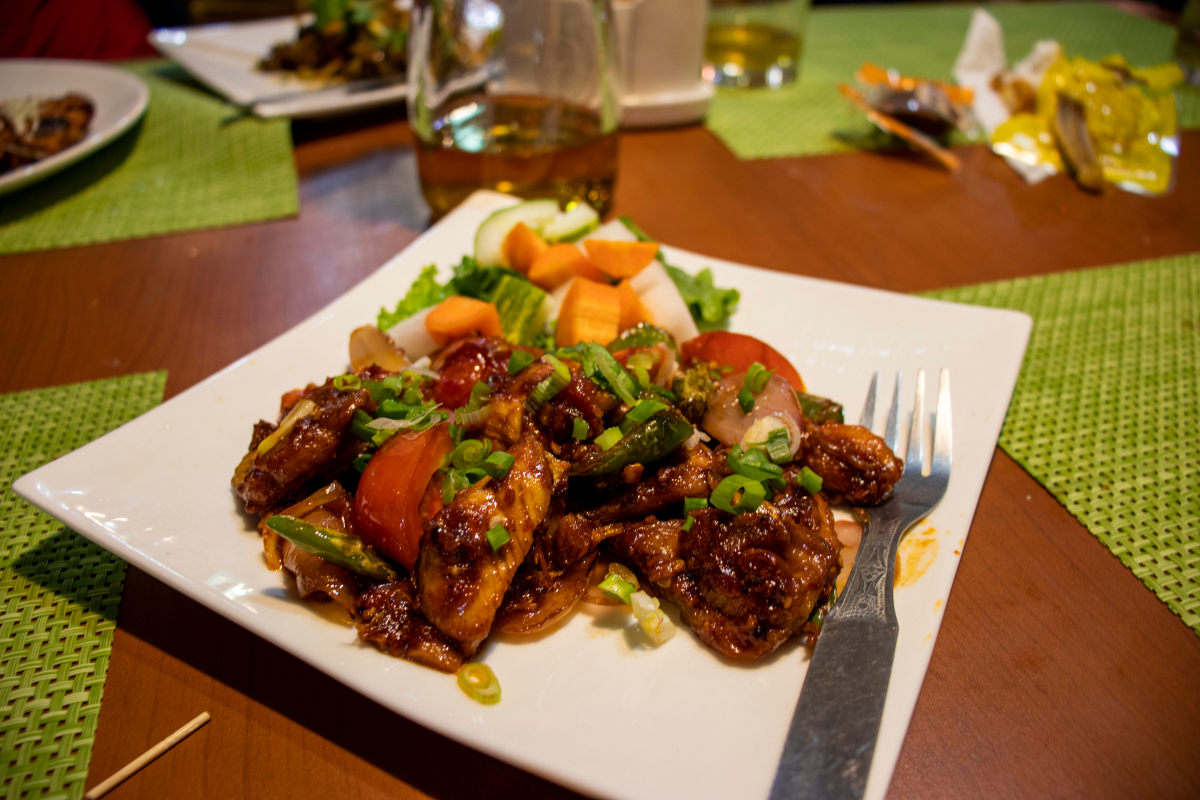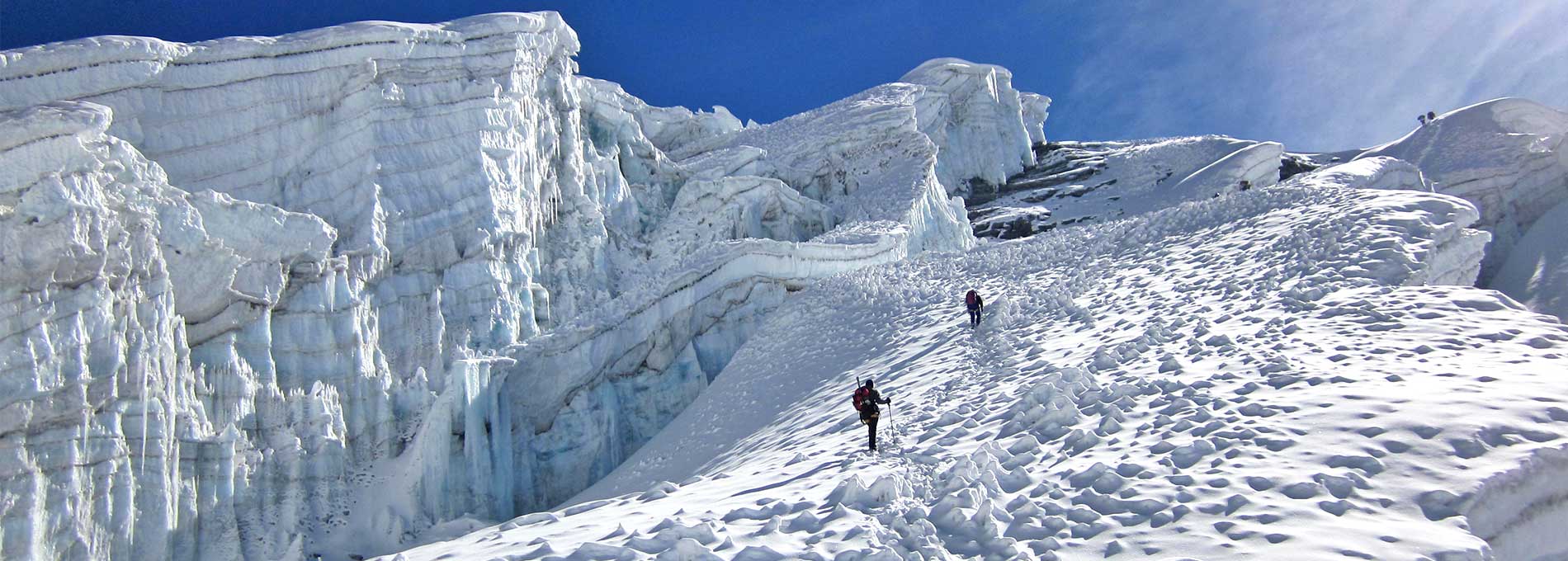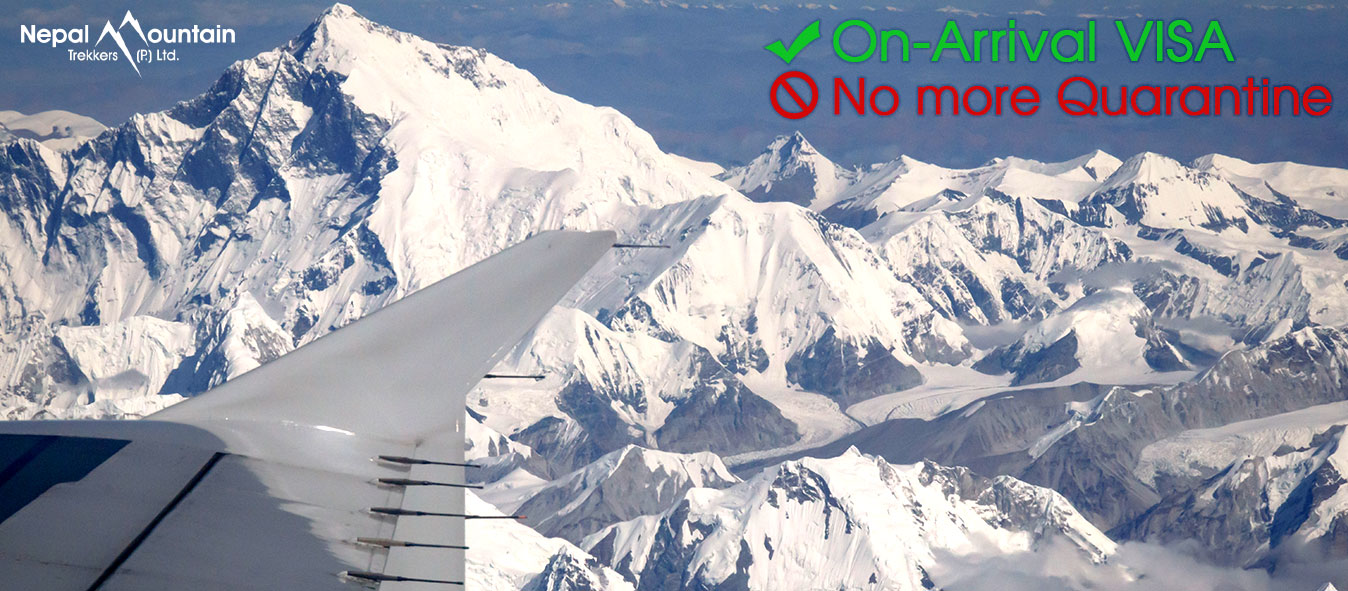Category: Nepal Travel Diaries
Blogs and travel news and updates from Nepal Mountain Trekkers.
2025
Tour and Trekking in Nepal: Your Ultimate 2025 Guide
Thinking of going on a trekking tour in Nepal? You’re in the right place. Nepal isn’t just a destination — it’s the world’s capital of trekking. With trails that wind through ancient villages, rhododendron forests, and past the tallest peaks on Earth, there’s no better place to walk, explore, and reconnect with nature.
Whether you’re a first-time hiker or an experienced adventurer, this guide explains everything you need to know about tour and trekking in Nepal, including the best treks, how to plan, what it costs, and how to do it safely with Nepal Mountain Trekkers.
📍 Why Trekking in Nepal Is Different
Trekking in Nepal is not just walking — it’s a cultural, scenic, and spiritual experience. The trails take you through places unreachable by road. You’ll meet locals who live simple lives in stone houses, hear Buddhist prayer flags flutter in the wind, and walk beneath Himalayan giants like Everest, Manaslu, and Annapurna.
🗺️ Best Trekking Tours in Nepal (2025 Update)
🔹 Ghorepani Poon Hill Trek
Duration: 5–7 days | Best for: Beginners & families
This short trek offers a perfect mix of Himalayan views, forests, and local culture. Poon Hill sunrise is world-famous and requires just moderate fitness.
🔹 Manaslu Circuit Trek
Duration: 14–18 days | Best for: Off-the-beaten-path seekers
Fewer crowds, wild terrain, and authentic mountain villages. This trek circles Mt. Manaslu (8,163m) and crosses the dramatic Larke Pass.
🔹 Annapurna Base Camp Trek
Duration: 8–12 days | Best for: First-timers wanting high mountains
Hike through lush valleys and steep ridges to reach the base of Annapurna I, one of the world’s deadliest peaks. Safe and rewarding.
🔹 Langtang Valley Trek
Duration: 7–10 days | Best for: Cultural experiences & glacier views
Just north of Kathmandu, this trek offers peaceful forests, Tamang heritage, and views of Langtang Lirung and glaciers.
🔹 Rara Lake Short Trek
Duration: 9–15 days | Best for: Remote lake lovers
Trek to the largest and deepest lake in Nepal. Rara Lake is quiet, magical, and far from the usual tourist crowds.
🛍️ Want help choosing the right trek? Browse our full Trekking in Nepal packages or contact us to customize your trip.
⏰ Best Time for Trekking in Nepal
| Season | Months | Why Trek Now? |
|---|---|---|
| Spring | March – May | Warm weather, rhododendron flowers, clear skies |
| Autumn | Sept – Nov | Best visibility, dry weather, festivals |
| Winter | Dec – Feb | Quieter trails, great for low-altitude treks |
| Monsoon | June – Aug | Ideal for Upper Mustang, fewer crowds |
💰 Trekking in Nepal Cost Guide (2025 Rates)
| Item | Estimated Cost (USD) |
|---|---|
| Trekking permits (avg.) | $30 – $100 |
| Guide per day | $25 – $35 |
| Porter per day | $20 – $25 |
| Meals + accommodation per day | $20 – $40 |
| Domestic Flights (e.g. Lukla) | $100 – $200 |
| Full trekking package (10–15 days) | $600 – $1,500+ |
We offer fair prices with no hidden costs. Let us handle permits, flights, and logistics so you can enjoy the journey.
✅ Trekking in Nepal for Beginners
Many beginners think trekking in Nepal is too hard. But it’s not. We have easy treks that are perfect for first-timers.
Best beginner treks:
We go at your pace, carry your bags, and keep you safe. You just need good shoes and a love for nature.
🏡 Tour vs Trek in Nepal: What’s the Difference?
- Trekking: Walking through villages and mountains for multiple days
- Touring: Exploring cities and countryside with transport
Combine both for the ultimate Nepal experience with our Best of Nepal Tour + Trek package.
📄 Trekking Permits You Need
Depending on the region, you might need:
- TIMS Card: ~$20
- National Park or Conservation Fee: ~$30
- Restricted Area Permit (e.g. Manaslu): $100+
💼 We take care of all permit arrangements for you.
🙌 Why Trek With Nepal Mountain Trekkers?
- Local, licensed, & experienced guides
- Honest pricing and clear communication
- 5-star rated on TripAdvisor
- Customizable packages for all fitness levels
- Committed to safety and sustainability
📝 Let’s Plan Your Nepal Trekking Tour
We’re here to help you every step of the way. Whether it’s the scenic Langtang trek, the challenging Manaslu Circuit, or the peaceful Rara Lake, we’ll build the perfect trip for you.
📞 WhatsApp: +977-9851069596
📧 Email: info@nepalmountaintrekkers.com
🔗 Contact Us
🔹 Related Articles
📈 Book early to secure 2025 trekking dates at the best prices.
2025
Manaslu Circuit Trek: Your Ultimate Guide with Nepal Mountain Trekkers
Introduction – The Manaslu Circuit
The Manaslu Circuit Trek is a breathtaking adventure in Nepal’s Himalayas, circling Mount Manaslu, the world’s eighth-highest peak at 8,163 meters (26,781 ft). Unlike the bustling trails of Everest Base Camp or Annapurna Circuit, this trek offers a remote, authentic experience with stunning landscapes and rich Tibetan culture. Whether you’re curious about its difficulty, cost, or how it stacks up against other treks, this guide, crafted by Nepal Mountain Trekkers, covers everything you need to plan your journey.
Difficulty and Fitness Requirements
How Difficult Is the Manaslu Circuit Trek?
The Manaslu Circuit Trek is moderately to highly challenging due to its high altitude, long walking days, and rugged terrain. The trek’s pinnacle, Larkya La Pass at 5,106 meters (16,752 ft), demands stamina for steep ascents and descents. Covering approximately 180 km, daily hikes range from 6 to 10 hours, with the longest day spanning 27 km and a 1,600-meter incline. It’s about 30% longer and steeper than Everest Base Camp, making it more demanding but not technically complex.
What Level of Fitness Is Required for trekking to Manaslu Circuit?
You’ll need strong cardiovascular endurance, leg strength, and core stability to tackle this trek. Comfortably walking 6-10 hours daily with a 5-10 kg daypack is essential. Prepare with activities like running, cycling, or hiking with a weighted backpack for 30-45 minutes, 4-5 times weekly, for at least 2-3 months. Prior trekking experience helps, but fit beginners can succeed with proper training and guidance from Nepal Mountain Trekkers.
Is the Manaslu Circuit Trek Suitable for Beginners?
Fit beginners can attempt the trek with thorough preparation, but it’s better suited for those with some high-altitude trekking experience due to the challenging terrain and altitude. A guide and a well-planned itinerary with acclimatization days are crucial for first-timers.
Is the Manaslu Circuit Trail Harder Than Everest Base Camp?
The Manaslu Circuit is generally considered harder than Everest Base Camp. It’s longer (180 km vs. 130 km), steeper, and less developed, with fewer facilities. However, its quieter trails and fewer crowds make it a rewarding choice for adventure seekers.
Itinerary and Duration of Manaslu Circuit Trek
How Long Does the Manaslu Circuit Trek Take?
The standard itinerary of the Manaslu Circuit Trek takes 14-18 days, including travel to and from Kathmandu. However, it could be personalized and customized as per the specification and requirements after communicating with us. For reference, a typical 13-day itinerary with Nepal Mountain Trekkers includes:
| Day | Activity | Description |
|---|---|---|
| 1 | Kathmandu to Machha Khola | Drive (8-10 hours) to the trailhead. |
| 2-10 | Trekking | Explore villages, forests, and rivers, culminating at Larkya La Pass on day 11. |
| 11 | Cross Larkya La Pass | Reach 5,106 meters for panoramic views of Manaslu and nearby peaks. |
| 12 | Bimthang to Dharapani | Descend to Dharapani. |
| 13 | Drive to Kathmandu/Pokhara | Return by bus or jeep (8-10 hours). |
Customizable Itineraries for Manaslu Trek:
- Shorter Treks: 11-12 day options skip side trips or start closer to the trailhead.
- Longer Treks: Adding Tsum Valley extends the trek to 18-20 days for a deeper cultural experience.
- Side Trips: Explore Manaslu Base Camp, Pungyen Gomba, or Birendra Lake for added adventure.
Cost Breakdown
How Much Does the Manaslu Circuit Trek Cost?
Costs for Manaslu Circuit Trek typically range from $1,500 to $2,500, depending on inclusions of services and the itinerary that you choose. Here’s a breakdown of costs that are incurred while trekking to Manaslu:
| Expense | Cost (USD) | Details |
|---|---|---|
| Permits | $100-$150 | Manaslu Restricted Area Permit ($100/week in peak season, $75/week off-season), Manaslu Conservation Area Permit ($30), Annapurna Conservation Area Permit ($30). |
| Guide | $25-$35/day | An experienced and licensed trekking guide is Mandatory for restricted areas; ensures safety and navigation. |
| Porter (Optional) | $20-$25/day or $299 for 13 days | Carries up to 15-20 kg of gear. |
| Accommodation | $5-$10/night | Teahouses with basic facilities. |
| Meals | $5-$10/meal | Breakfast, lunch, and dinner at teahouses. |
| Transportation | $50-$100 | Bus or jeep from Kathmandu to trailhead and back. |
| Miscellaneous | $100-$200 | Tips, device charging ($2-$3 per charge), personal expenses. |
Tips for Budgeting
- Join a group trek to share costs.
- Book with Nepal Mountain Trekkers for competitive pricing and tailored packages.
- Bring a power bank to avoid teahouse charging fees.
Cost of Manaslu Circuit Trek for Indians and Nepalis
During a trek to the Manaslu region, Indian and Nepali trekkers may enjoy lower permit fees (e.g., Manaslu Conservation Area Permit at ~$10 for SAARC nationals). Contact Nepal Mountain Trekkers for specific pricing.
Safety and Precautions
What Is the Death Rate of the Manaslu Circuit Trek?
The trek has a low death rate compared to climbing Manaslu’s summit, which recorded 53 fatalities in 297 ascents by 2008 (Wikipedia). Risks include altitude sickness, landslides, and unpredictable weather, but fatalities are rare with proper preparation. Severe altitude sickness may require immediate descent or helicopter evacuation.
Safety Tips
- Acclimatization: Choose itineraries with rest days to adjust to high altitudes.
- Guides: Hire experienced guides from Nepal Mountain Trekkers for safety and navigation.
- Gear: Pack trekking boots, warm layers, and a sleeping bag rated for -10°C to -20°C.
- Insurance: Secure travel insurance covering high-altitude trekking and emergency evacuation.
Best Time to Trek Manaslu Circuit
The optimal seasons are:
- Spring (March-May): Mild weather, blooming rhododendrons, and clear views.
- Autumn (September-November): Stable weather, clear skies, and ideal trail conditions.
Avoid the monsoon season (June-August) due to heavy rain and landslide risks. Winter (December-February) is feasible but challenging due to cold and snow at higher altitudes.
Comparisons with Other Treks
Manaslu Circuit vs. Annapurna Circuit
| Aspect | Manaslu Circuit | Annapurna Circuit |
|---|---|---|
| Crowds | Less crowded, remote | More crowded, popular |
| Difficulty | Steeper, more challenging | Moderate, better facilities |
| Culture | Authentic Tibetan villages | Diverse cultural mix |
| Permits | Restricted Area Permit required | No restricted permit needed |
Manaslu offers a quieter, more authentic experience, while Annapurna is more developed. Learn more about Annapurna at Nepal Mountain Trekkers.
Manaslu Circuit vs. Everest Base Camp
| Aspect | Manaslu Circuit | Everest Base Camp |
|---|---|---|
| Distance | 180 km | 130 km |
| Difficulty | Harder, steeper | Moderate, well-trodden |
| Altitude | 5,106 m (Larkya La Pass) | 5,364 m (Base Camp) |
| Crowds | Less crowded | Very crowded |
Manaslu is perfect for solitude seekers, while Everest Base Camp is iconic but busier. Explore Everest options at Nepal Mountain Trekkers.
Can You See Mt. Manaslu from the Annapurna Circuit?
Mt. Manaslu, the 10th highest mountain in the world, is visible from certain points on the Annapurna Circuit, like Thorong La Pass, but it’s not a primary highlight.
Which Is Better: Manaslu, Annapurna Circuit, or ABC Trek?
- Manaslu Circuit: Best for remote, cultural experiences.
- Annapurna Circuit: Ideal for diverse scenery and facilities.
- Annapurna Base Camp (ABC): Shorter (7-12 days), focused on mountain views.
Your choice depends on your preference for solitude, challenge, or accessibility. Compare all treks at Nepal Mountain Trekkers.
Practical Information
How to Get There
- Fly to Tribhuvan International Airport in Kathmandu.
- Take a bus or jeep (8-10 hours) to Arughat or Machha Khola.
- Return from Dharapani to Kathmandu or Pokhara by bus or jeep.
What to Pack
- Clothing: Thermal base layers, fleece/down jacket, waterproof jacket/pants, trekking boots, camp shoes.
- Gear: 50-60L backpack, 20-30L daypack, trekking poles, headlamp, sleeping bag (-10°C to -20°C).
- Essentials: Water purification tablets, first aid kit, sunscreen, sunglasses.
- Electronics: Power bank to avoid teahouse charging fees ($2-$3 per device).
Accommodation
Teahouses offer basic lodging and meals, costing $5-$10 per night. Expect shared rooms and simple facilities.
Local Culture and Etiquette
- Dress modestly in villages.
- Ask permission before photographing locals.
- Support communities by hiring local guides and porters through Nepal Mountain Trekkers.
Conclusion
The Manaslu Circuit Trek is a challenging yet rewarding adventure, offering stunning views, rich cultural immersion, and a quieter alternative to Nepal’s popular treks. With proper preparation and expert guidance from Nepal Mountain Trekkers, you can conquer this Himalayan gem. Ready to start your journey? Contact us at Nepal Mountain Trekkers to book your trek today!
FAQ
Is the Manaslu Circuit Trek for Beginners?
Fit beginners can attempt it with training and a guide, but it’s better suited for experienced trekkers due to its altitude and duration.
Can You Do the Manaslu Circuit Without a Guide?
A guide is highly recommended due to restricted area regulations and safety concerns. Book with Nepal Mountain Trekkers for hassle-free permits.
What Is the Most Difficult Part of the Manaslu Circuit?
Crossing Larkya La Pass (5,106 m) is the toughest due to its altitude and steep terrain.
What Is the Best Trek in Nepal?
It depends on your goals:
- Manaslu Circuit: Remote and cultural.
- Everest Base Camp: Iconic and crowded.
- Annapurna Circuit: Scenic and accessible.
Explore all options at Nepal Mountain Trekkers.
2025
Nepal Named Among World’s Top Solo Adventure Destinations for 2025
Nepal has secured its place as the 7th best solo adventure destination for 2025, as recognized by UK-based travel company Much Better Adventures. This prestigious ranking underscores Nepal’s unique appeal for independent travelers seeking thrilling experiences amidst breathtaking natural beauty. With its majestic Himalayan peaks, rich cultural heritage, and a wide array of adventure activities, Nepal offers an unforgettable journey for those exploring solo. Whether you’re trekking through rugged mountains, rafting wild rivers, or immersing yourself in vibrant local culture, Nepal promises a transformative adventure. At Nepal Mountain Trekkers, we’re here to help you plan your perfect solo adventure with tailored itineraries and expert guides.
Why Nepal is Ideal for Solo Travelers
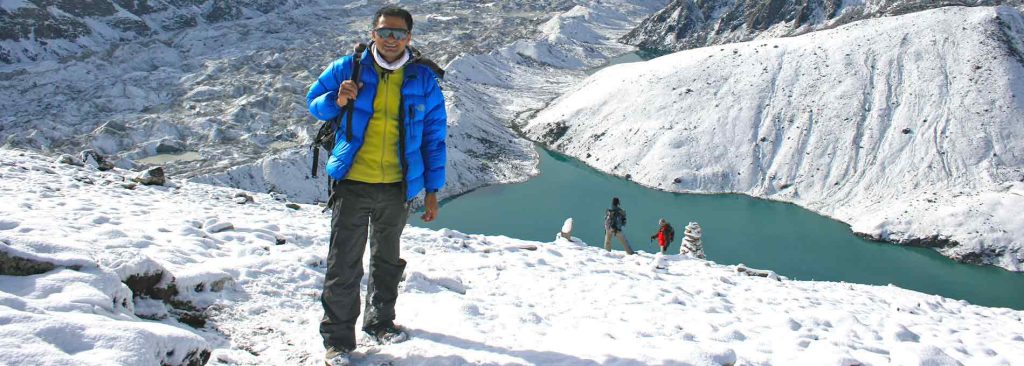
Nepal’s allure for solo adventurers stems from its diverse offerings, combining natural splendor, thrilling activities, and a welcoming environment. Here’s why it stands out as a top destination for solo travel in 2025:
- Breathtaking Landscapes: Nepal is home to eight of the world’s ten highest mountains, including Mount Everest. The Himalayas provide a dramatic backdrop for trekking, with routes ranging from beginner-friendly day hikes to challenging multi-day expeditions like the Annapurna Circuit Trek. The country’s Global Biodiversity Index score of 102.56 ensures a rich experience for nature lovers.
- Adventure Activities: From the iconic Everest Base Camp Trek to white-water rafting in Chitwan National Park, Nepal is an adventure playground. Solo travelers can also enjoy canyoning, paragliding, and mountain biking, catering to various thrill levels. Our Chitwan National Park Tour offers a perfect blend of wildlife safaris and river adventures.
- Welcoming Locals: Nepalese are renowned for their hospitality, making solo travelers feel at ease. In urban areas like Kathmandu and Pokhara, many locals speak English, simplifying communication. For trekkers, mandatory local guides, as required since March 2023, ensure safety while offering cultural insights and companionship through stays at village teahouses.
- Affordability: Nepal is one of Asia’s most budget-friendly destinations. With an average meal costing just £1.40 (approximately NPR 240), travelers can savor local cuisine like mo:mo and dal bhat without straining their wallets. Accommodation options, from basic teahouses to luxury hotels, cater to all budgets, making it ideal for solo travelers.
- Safety: With a safety score of 2.07, Nepal is a secure destination for solo travelers, including solo female travelers. Its traveler-friendly visa policies, including visa on arrival or eVisa for stays up to 150 days, make planning hassle-free. Nepal’s accessibility and safety make it a top choice for independent adventurers.
Top Solo Adventure Experiences in Nepal
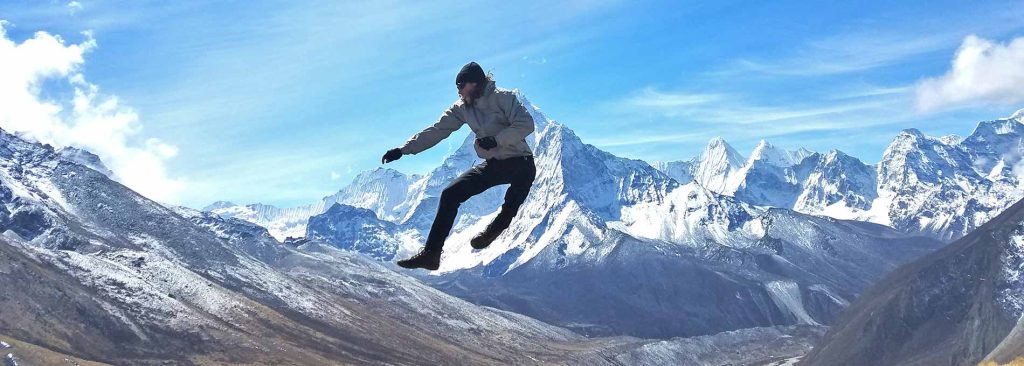
Nepal’s ranking is bolstered by its diverse range of experiences, perfect for solo adventurers seeking both adrenaline and cultural enrichment. Here are some highlights:
- Trekking to Everest Base Camp
The Everest Base Camp Trek is a bucket-list adventure that takes you through Sherpa villages, lush forests, and rugged Himalayan terrain. The journey offers stunning views of Mount Everest and a deep dive into Sherpa culture. With our experienced guides at Nepal Mountain Trekkers, solo travelers can enjoy a safe and enriching experience.
Best for: Trekkers and adventure seekers.
Why it’s solo-friendly: Mandatory guides and teahouse stays foster a sense of community. - Wildlife and Rafting in Chitwan National Park
Chitwan National Park, a UNESCO World Heritage Site, is a biodiversity hotspot home to one-horned rhinoceroses, Bengal tigers, and diverse bird species. Solo travelers can enjoy thrilling white-water rafting on the Rapti River, jungle safaris, or canoe rides to spot wildlife. Our Chitwan National Park Tour is designed to connect solo travelers with like-minded adventurers.
Best for: Nature lovers and thrill-seekers.
Why it’s solo-friendly: Group activities and guided tours make socializing easy. - Cultural Exploration in Kathmandu and Pokhara
Kathmandu, Nepal’s vibrant capital, is a treasure trove of ancient temples, bustling markets, and historic sites like Swayambhunath (Monkey Temple) and Boudhanath Stupa. Our Kathmandu City Tour offers solo travelers a chance to explore these cultural gems with expert guides. Pokhara, nestled against the Annapurna range, offers serene lakes, paragliding, and a relaxed atmosphere perfect for unwinding.
Best for: Culture enthusiasts and explorers.
Why it’s solo-friendly: English-speaking locals and vibrant traveler communities make it easy to connect.
Table: Top Solo Adventure Activities in Nepal
| Activity | Location | Highlights | Best For |
|---|---|---|---|
| Everest Base Camp Trek | Khumbu Region | Stunning Himalayan views, Sherpa culture, challenging trails | Trekkers, adventure seekers |
| Rafting and Safaris in Chitwan | Chitwan National Park | Wildlife spotting, white-water rafting, jungle exploration | Nature lovers, thrill-seekers |
| Cultural Exploration | Kathmandu & Pokhara | Ancient temples, vibrant markets, serene lakes, paragliding | Culture enthusiasts, explorers |
Practical Information for Solo Travelers
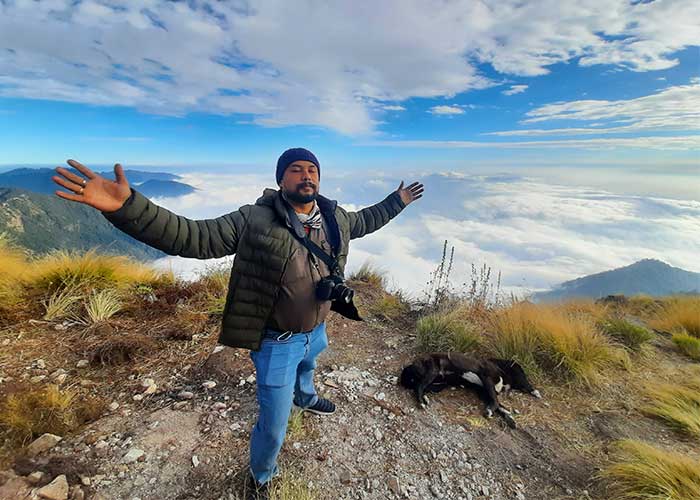
Planning a solo trip to Nepal is straightforward, thanks to its accessible infrastructure and traveler-friendly policies. Here’s what you need to know:
- How to Get There: The primary gateway is Tribhuvan International Airport in Kathmandu. Flights from London take approximately 11 hours and 30 minutes, with several airlines, including Qatar Airways and Turkish Airlines, offering direct and connecting options from major global cities.
- Visa Requirements: Tourists can obtain a visa on arrival or apply for an eVisa for Nepal online. Visas are available for 15, 30, or 90 days, with the option to extend up to 150 days, making long-term exploration feasible.
- Best Time to Visit: The optimal seasons for trekking and outdoor activities are spring (March to May) and autumn (September to November), when clear skies and mild temperatures enhance the experience.
- Accommodation Options: Trekkers can stay in teahouses along trails, offering basic but cozy lodging. In cities, options range from budget hostels to luxury hotels, ensuring flexibility for all budgets. Check out our Solo Travel Packages for tailored accommodation options.
- Biodiversity and Accessibility: Nepal boasts a Global Biodiversity Index score of 102.56, making it a paradise for nature lovers. Its accessibility, combined with affordability, ensures solo travelers can explore without logistical hurdles.
Table: Practical Travel Details for Nepal
| Aspect | Details |
|---|---|
| Main Airport | Tribhuvan International Airport, Kathmandu |
| Flight Time from London | ~11 hours 30 minutes |
| Visa Options | Visa on arrival or eVisa (15, 30, or 90 days, extendable to 150 days) |
| Best Travel Seasons | Spring (March–May), Autumn (September–November) |
| Average Meal Cost | £1.40 (approx. NPR 240) |
| Safety Score | 2.07 (highly safe for solo travelers) |
Why Choose Nepal Mountain Trekkers?
At Nepal Mountain Trekkers, we specialize in crafting unforgettable adventures for solo travelers. Our expert guides, personalized itineraries, and commitment to safety and sustainability ensure a seamless and enriching experience. Whether you’re embarking on the Everest Base Camp Trek, exploring Chitwan National Park, or discovering the cultural treasures of Kathmandu with our Kathmandu City Tour, we’re here to make your solo journey unforgettable. Our Solo Travel Packages are designed to cater to independent travelers, offering flexibility and support every step of the way.
Conclusion
Nepal’s ranking as the 7th best solo adventure destination for 2025 by Much Better Adventures reflects its unparalleled blend of natural beauty, thrilling activities, and welcoming culture. For solo travelers eager to push their limits, immerse in new cultures, and create lasting memories, Nepal is a must-visit destination. Whether you’re scaling Himalayan peaks, rafting through jungles, or wandering ancient streets, Nepal promises an adventure that captivates both heart and soul. Start planning your solo adventure with Nepal Mountain Trekkers today and discover why Nepal is the ultimate destination for thrill-seekers and culture enthusiasts in 2025.
Explore More with Nepal Mountain Trekkers
Ready to embark on your solo adventure in Nepal? Explore our curated packages and treks:
- Everest Base Camp Trek
- Annapurna Circuit Trek
- Chitwan National Park Tour
- Kathmandu City Tour
- Solo Travel Packages
2025
Top 10 Treks in Nepal for 2025 Sept/Oct
Hey there, adventure lovers! Are you ready to lace up your boots and hit the trails in Nepal? The Himalayas are calling, and 2025 is gonna be an epic year for trekking in Nepal. With new routes popping up and a big focus on sustainable tourism, there’s something for everyone—whether you’re a newbie or a pro trekker. I’ve been lucky enough to explore some of these trails myself, and let me tell you, the views and vibes are out of this world!
In this blog, I’m sharing the top 10 treks in Nepal for 2025 that are trending big time. These are the ones folks from the US, Australia, Canada, Germany, and even Nepal itself are raving about. So, grab a coffee, get comfy, and let’s dive into these Top 10 Treks in Nepal 2025 – the must-do adventures!
List of Top 10 Treks in Nepal for 2025:
1. Everest Base Camp Trekking 2025
This is the big one—Everest Base Camp Trek 2025! Standing at the foot of the world’s highest mountain is a bucket-list moment. The trail winds through Sherpa villages, past monasteries, and offers jaw-dropping views of the Khumbu Icefall. I remember my first glimpse of Everest; it gave me goosebumps!
- Best Time: March to May, September to November
- Duration: 14 to 16 days
- Difficulty: Moderate
- Why Go: Stunning Himalayan views, rich Sherpa culture, and that unbeatable sense of achievement.
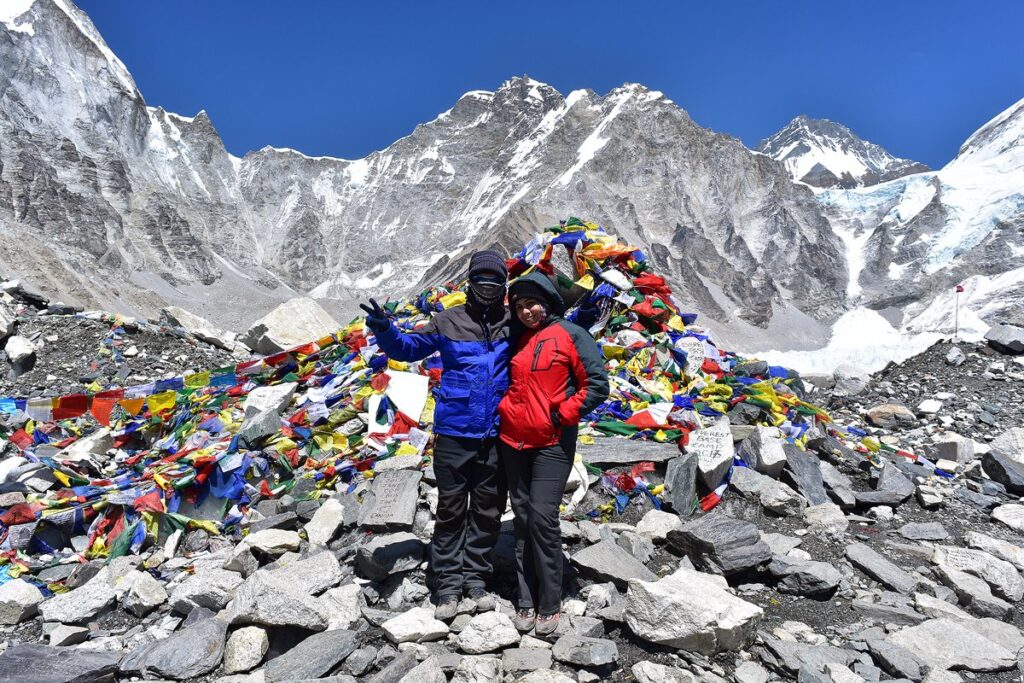
Plan your Everest Base Camp Trekking adventure with Nepal Mountain Trekkers.
2. Everest Three High Passes Trek 2025
If you’re up for a serious challenge, the Everest Three High Passes Trek is your jam. You’ll cross three epic passes—Renjo La, Cho La, and Kongma La. It’s tough, but the views of snow-capped peaks and glaciers make it so worth it.
- Best Time: March, April, September, October, November
- Duration: 18 to 21 days
- Difficulty: Very Strenuous
- Why Go: Thrilling high-altitude passes and unmatched scenery.
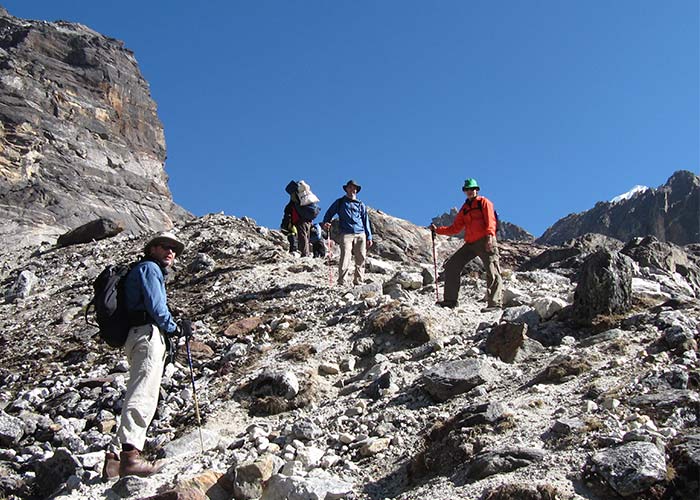
Check the Everest Three High Passes Trek itinerary and cost details with Nepal Mountain Trekkers.
3. Annapurna Circuit Trek 2025
The Annapurna Circuit Trek 2025 is a classic for a reason. It’s got everything—lush forests, high-altitude deserts, and views of Annapurna and Dhaulagiri. You’ll pass through Gurung villages and cross the Thorong La Pass. It’s like a journey through different worlds!
- Best Time: September to November, March to May
- Duration: 14 to 21 days
- Difficulty: Moderately difficult
- Why Go: Diverse landscapes and cultural immersion.
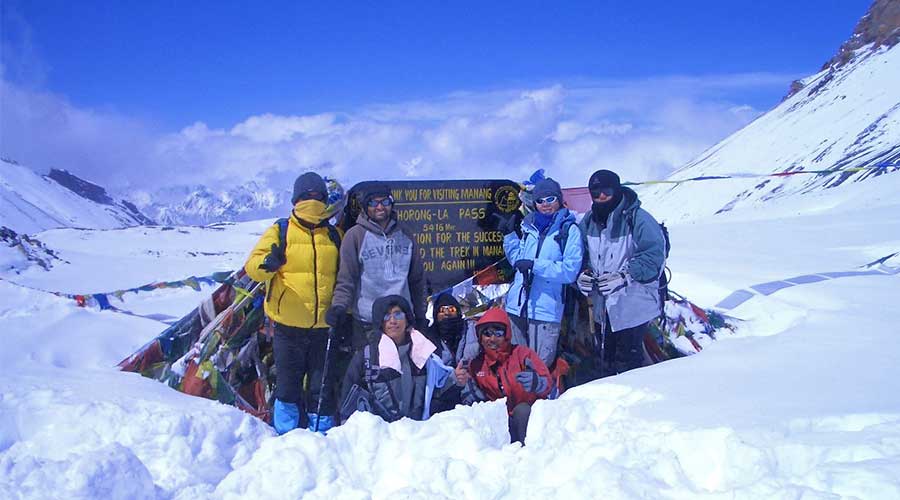
Book your Annapurna Circuit Trek with Nepal Mountain Trekkers.
4. Upper Mustang Trekking 2025
Upper Mustang is like stepping into a time machine. This ancient kingdom, with its Tibetan vibes, has red cliffs and monasteries that feel straight out of a movie. The landscape is unreal, and the culture is so unique. Besides trekking, Upper Mustang Jeep Tour, Upper Mustang Horse Riding, and Upper Mustang Mountain Biking Tour are also popular activities in the Mustang region of Nepal.
- Best Time: March to November
- Duration: 14 to 21 days
- Difficulty: Moderate
- Why Go: Unique desert scenery and ancient monasteries.

Explore more about Upper Mustang Trekking itinerary, cost, and other details with Nepal Mountain Trekkers.
5. Manaslu Circuit Trekking 2025
The Manaslu Circuit Trek is a hidden gem for those who want to escape the crowds. You’ll trek past the eighth-highest mountain, Manaslu, and through Gurung and Tibetan villages. The hospitality here is heartwarming!
- Best Time: March to May, September to November
- Duration: 13 to 17 days
- Difficulty: Challenging
- Why Go: Pristine landscapes and authentic cultural experiences.
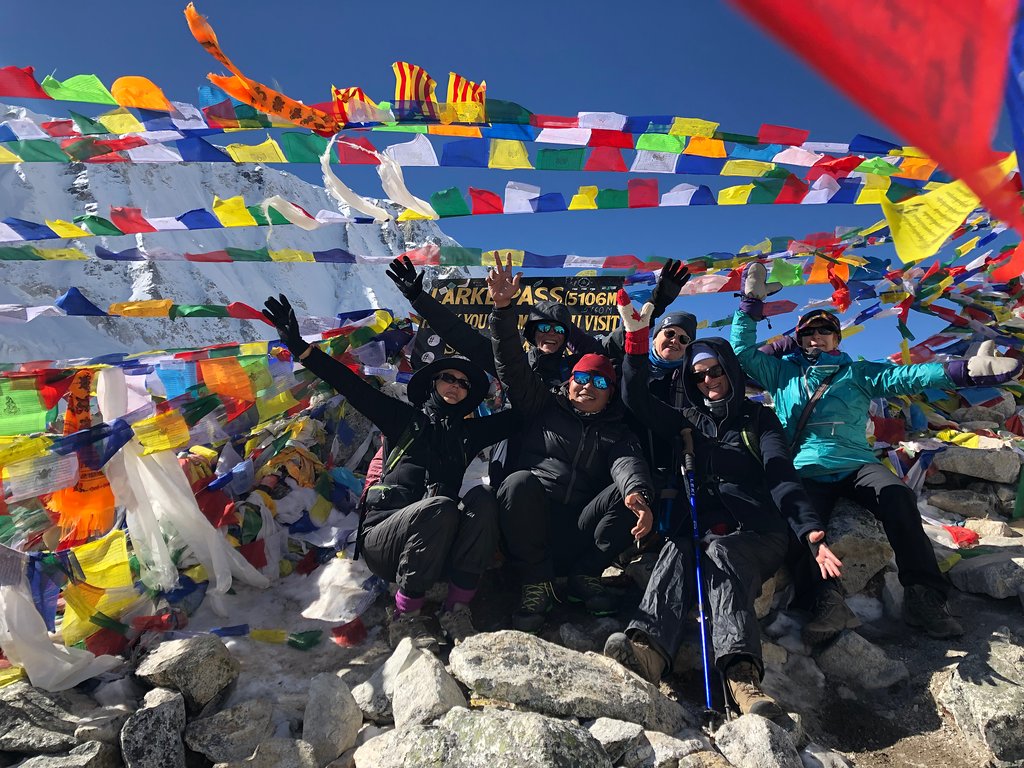
Get details about Manaslu Circuit Trekking at Nepal Mountain Trekkers.
6. Langtang Gosainkunda Trekking 2025
If you’re after peace and quiet, the Langtang Gosainkunda Trek is perfect. The Langtang Valley has lush forests and cozy villages, plus the sacred Gosainkunda Lakes, which are super spiritual. It’s less crowded but just as beautiful.
- Best Time: October, November, March to May
- Duration: 12 to 16 days
- Difficulty: Moderate
- Why Go: Serene beauty and spiritual significance.
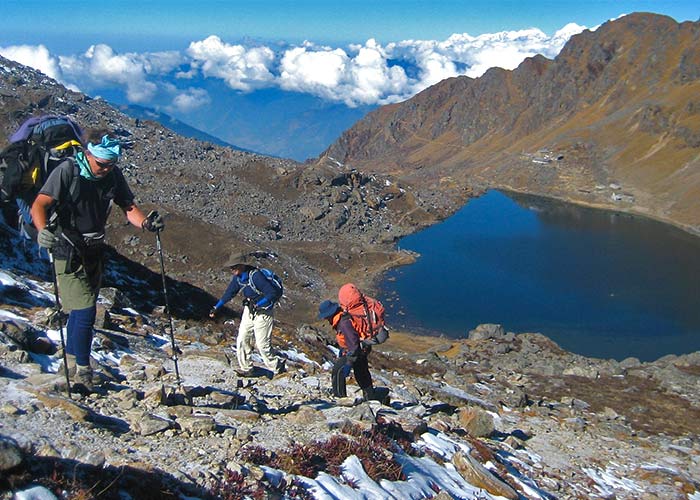
Plan Langtang Gosainkunda Trekking with Nepal Mountain Trekkers.
7. Rara Lake Trekking 2025
Rara Lake Trek takes you to Nepal’s largest lake, tucked away in a remote national park. It’s a bit off the radar, which makes it perfect for those who love untouched nature and spotting wildlife.
- Best Time: September to November, March to May
- Duration: Minimum 6 days
- Difficulty: Moderate
- Why Go: Tranquil lake views and rare wildlife sightings.
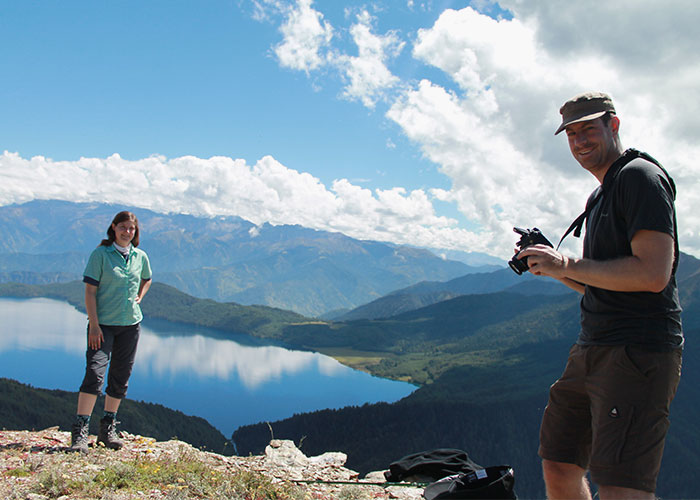
Book Rara Lake Trekking now at Nepal Mountain Trekkers.
8. Rolwaling Valley Trekking 2025
Rolwaling Valley is a hidden treasure with snow-capped peaks and serene forests. The Tso Rolpa Lake is a highlight, and the villages along the way are so welcoming. It’s a trek for those who want adventure without the hustle.
- Best Time: March to May, September to mid-December
- Duration: 12 to 19 days
- Difficulty: Moderate
- Why Go: Peaceful trails and stunning mountain views.

Find out more about Rolwaling Valley Trekking at Nepal Mountain Trekkers.
9. Annapurna Base Camp Trekking 2025
The Annapurna Base Camp Trek 2025 is a shorter but epic adventure. You’ll stand at the foot of Annapurna I, surrounded by towering peaks like Machhapuchhre (Fishtail). The Gurung villages add a cultural touch that’s hard to beat.
- Best Time: March to May, mid-September to mid-December
- Duration: 8 to 15 days
- Difficulty: Moderate
- Why Go: Breathtaking views and charming villages.
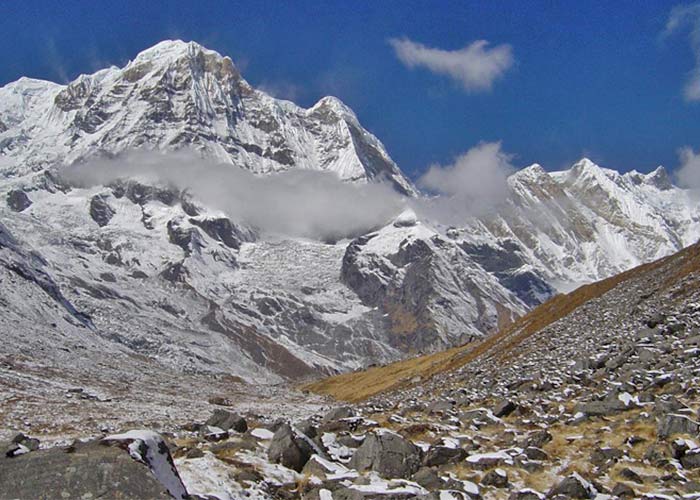
Book your Annapurna Base Camp Trek at Nepal Mountain Trekkers.
10. Khopra-Danda Trek 2025
Last but not least, the Khopra-Danda Trek is a lesser-known gem in the Annapurna region. Think panoramic views of Annapurna and Dhaulagiri, plus trails lined with blooming rhododendrons in spring. It’s a quieter option for nature lovers.
- Best Time: March to May, mid-September to mid-December
- Duration: 7 to 14 days
- Difficulty: Moderate
- Why Go: Less crowded trails and stunning vistas.
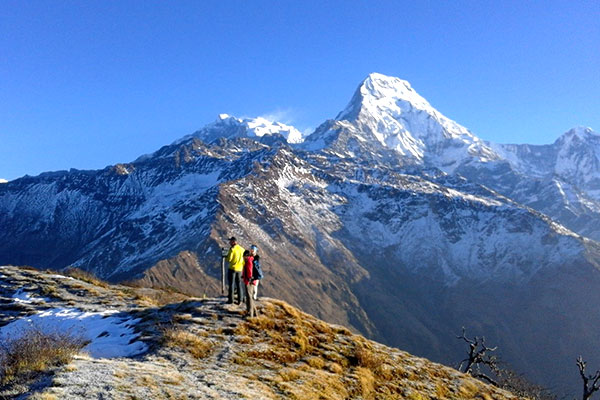
Discover the Khopra-Danda Trek at Nepal Mountain Trekkers.
Sustainable Trekking in Nepal 2025 – Top 10 Treks in Nepal for 2025 Sept/Oct
Eco trekking Nepal 2025 is a big deal these days. More and more operators are focusing on sustainable trekking in Nepal, using local guides, supporting communities, and cutting down on waste. When you pick your trek, go for a company that cares about the environment and locals—it makes your adventure even more meaningful!
Tips for Your Top 10 Trek in Nepal for 2025
- Pack Smart: Bring sturdy boots, a good camera, and extra snacks (trust me, you’ll need ‘em!).
- Stay Safe: Watch out for altitude sickness and follow your guide’s advice.
- Connect: Chat with locals along the way; their stories make the trek unforgettable.
Why These Top 10 Treks in Nepal for 2025 Are Trending
These treks are drawing crowds from places like Germany, India, and Nepal itself, based on recent booking trends. Whether it’s the iconic Everest Base Camp Trek or the remote Rara Lake, each offers something special. Plus, with new treks in Nepal 2025 gaining attention, there’s no shortage of options.
Conclusion: Top 10 Treks in Nepal for 2025
There you go—the top 10 treks in Nepal for Sept to November 2025 and March to May 2026! From the thrill of Everest to the calm of Rara Lake, these adventures are sure to leave you with memories that last a lifetime. So, what’re you waiting for? Start planning, pack your bags, and get ready to explore the Himalayas. Which one of the top 10 treks in Nepal for 2025 is calling your name? Contact us and let us know!
Happy trekking in Nepal 2025/2026!
2025
Gosaikunda Trek: An emotional and spiritual trekking place in Nepal
Around 2pm, our bus left us behind at Dhunche. The clouds looked heavy, and the cold breeze hinted at rain. I unwillingly purchased a raincoat from a local shop, a decision I would soon be thankful for. As we started trekking, tea breaks became our energy drinks. Each cup of tea from the small and local tea houses along the trail warmed not only our hands but also our spirits. We needed it because, not long after we started walking up hill, the rain decided to join our trek. The visibility was poor, and the little drizzle of rain made the paths slippery. So, we took short breaks and even adjusted our itinerary, deciding to stay overnight at Deurali.
The journey up to Deurali was pleasant despite the rain. On the way, we passed a small river and some houses where two little kids peeked shyly at us from behind the door. Their innocence made me pause and smile. These little moments are what makes Nepal trekking so special – the people, their simplicity, and the raw beauty of their livelihood.
We reached Deurali feeling exhausted and cold. Altitude sickness was a concern, so we decided to take the trek slow and not hurry. The next morning, after brushing my teeth and stepping outside for fresh air, my eyes were pleased by a view I will never forget. The snow-covered mountains stood tall and I felt those mountains were looking directly into my eyes. It felt unreal – like the mountains were close enough to touch. This was my first time being so close to the Himalayas, and my excitement knew no bounds. I ran back inside, shouting at my still-asleep friends to wake up and witness the view. Sleepy and slightly annoyed at me for waking them up, they came outside, but their angry faces quickly turned into wide smiles. Suddenly, everyone was cheering and laughing. The mountains had a magical effect on all of us.
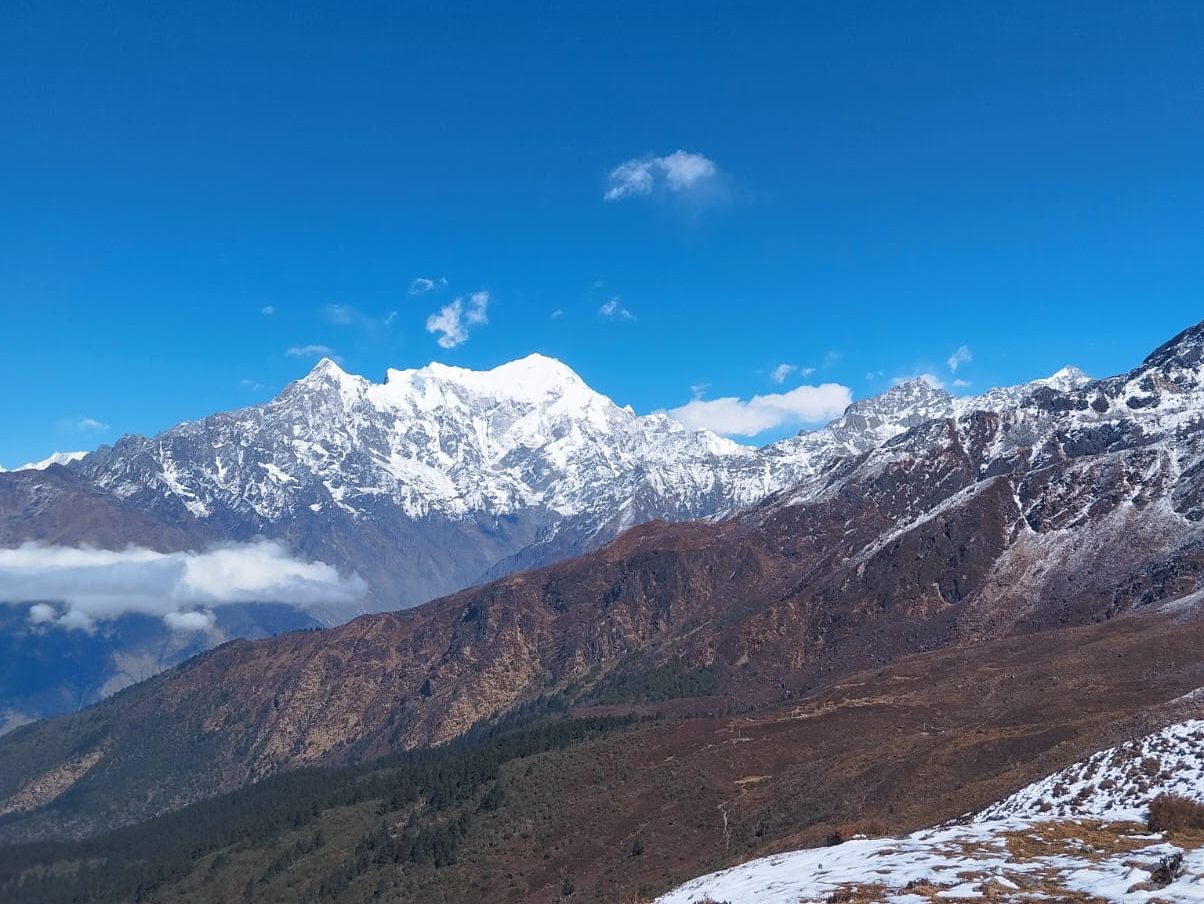
The cold was biting that morning, and the water in the taps was barely touchable – it felt like ice! We were trekking in early November, and the chill was as real as the adventure. After a light breakfast and clicking countless photos of the stunning mountains, we group of seven hit the trail again after drinking hot cup of tea for warming ourselves.
The landscape seemed to change as we come closer to the lake. We saw breathtaking views of the Himalayas, horses grazing peacefully in the fields, and local villagers gathering wood for their evening fires. The cold air kissed our faces as we walked, and the friendship of our group made it even more enjoyable. We sang songs, cracked jokes, and shared snacks along the way until we reached Cholang Pati for our long-waited Dal Bhat.
“Dal-bhat power 24 hour” is common and famous phrase among tourist and Nepalese people.
At Cholang Pati, we stopped for lunch, simple yet delicious dal bhat. This spot was like a heaven, surrounded by towering mountains on all sides. After eating, we spent some time playing local instruments that the tea house owner had. Some of us even tried horse riding, a fun activity available for trekkers who might find walking challenging localdlish. Gosaikunda lake trekking offers options for everyone, whether you’re trekking on foot or on horse.
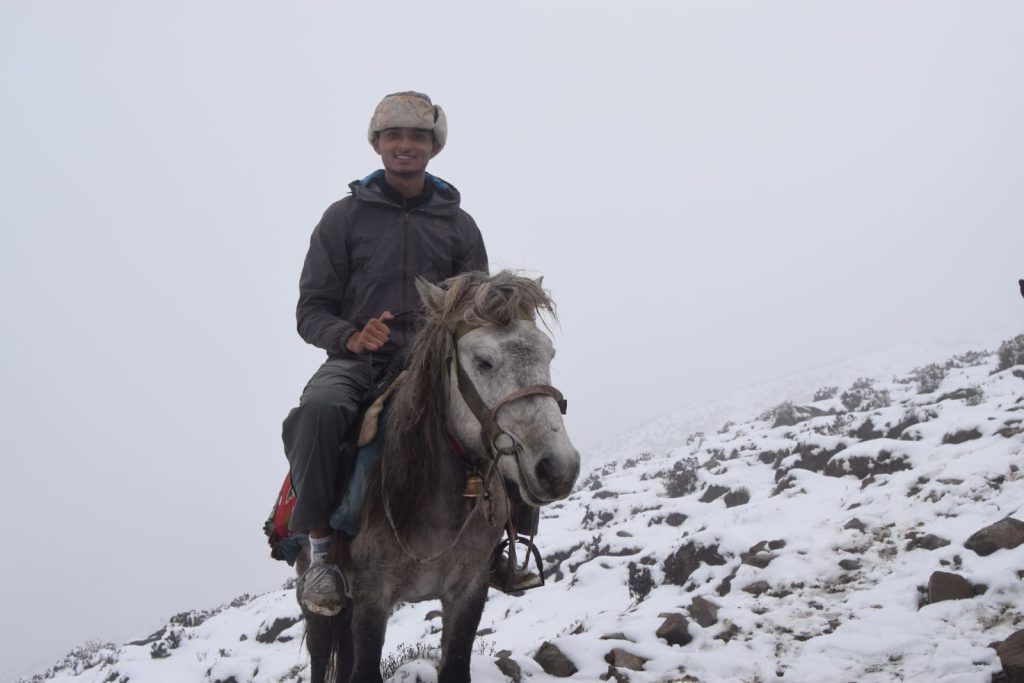
With time running short, we decided to head straight to Gosaikunda lake with elevation of 4,380 meters. The higher we went, the colder it got. The fog surrounded us limiting our visibility, and by the time we reached on top, it was almost night. It was hard to see anything because of the fog, and we were shivering from the cold. However, we received a warm welcome at one of the lodges. Many hotels were closed for the season, but the ones that remained open worked together to serve trekkers like us. The owner’s dedication to run these lodges in such harsh conditions amazed me. If they were not there to serve us, this trek would be one of the hardest treks in Nepal.
We spent the evening sitting around a fireplace in the lodge’s main hall, sharing stories and laughter with strangers. It didn’t matter that we didn’t know each other’s names or backgrounds; the cold had united us together. That evening, surrounded by warmth and laughter, felt like one of the best moments of my life.
The next morning, I was woken by some noise outside the lodge. Curious, I grabbed my jacket and stepped out. What I saw left me speechless. The fog was no were to be found, and right before me was Gosaikunda Lake, its shiny blue surface surrounded by rugged and snow-capped mountains. It felt like a dream. Me and my friends, we all ran down to the lake, our excitement left the ground after seeing what we were talking about the other day.

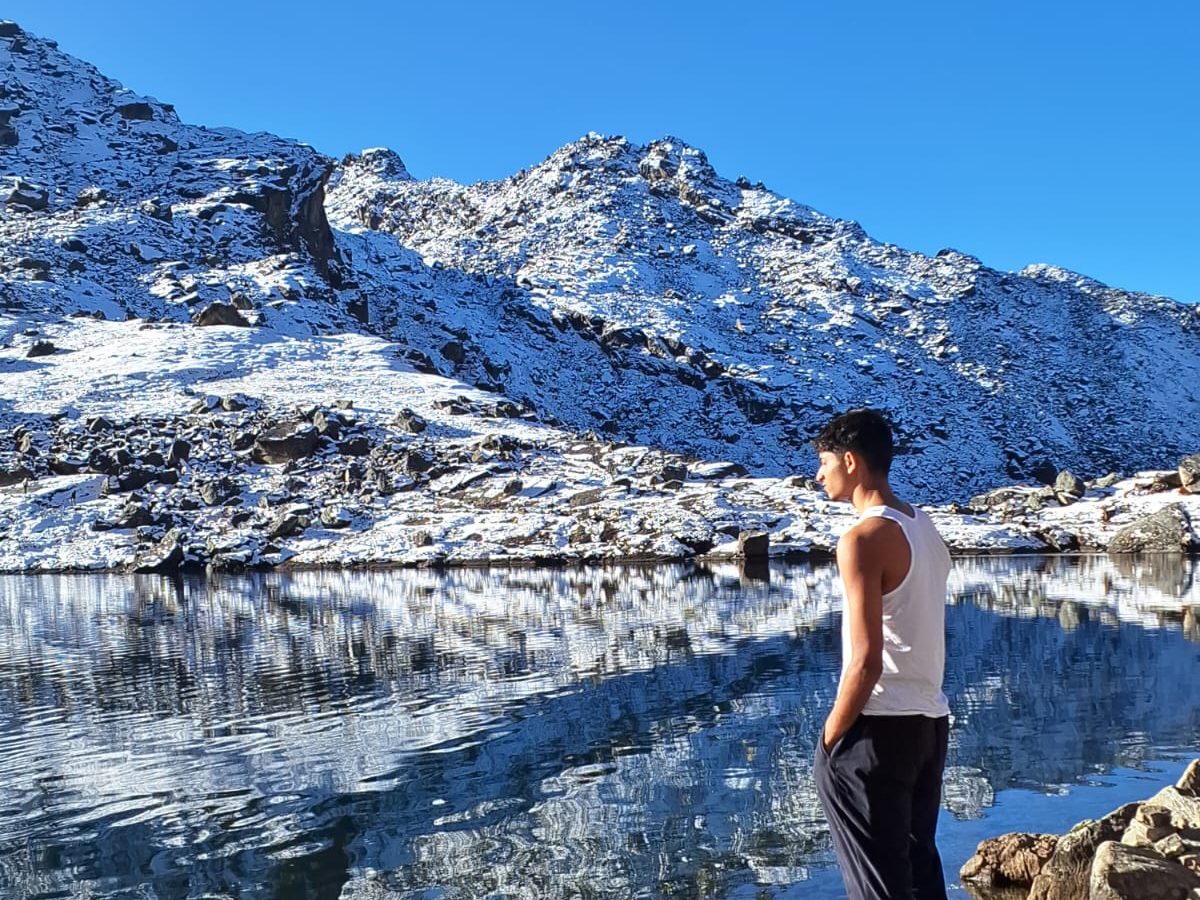
The lake is considered holy in Hindu tradition and is believed to have been created by Lord Shiva. People often say, if we look closely inside the water, we can find lord Shiva resting down. We tried seeing but could not see properly. There’s a small temple near the lake, and many pilgrims visit to offer prayers and sprinkle the lake’s holy water in their homes for blessings. We spent some time at the temple praying for our family members and our loved once. Then someone from our group had a crazy idea: why not take a dip in the lake?
The water was freezing, so cold that just touching it sent shivers down our spines. But the belief that a holy dip would erase our sins gave us purpose to take a dive. Laughing and shivering, we brought our extra clothes and started taking our cloths off. We all seven of us jumped into the icy water. Just to let you know, we were there only for few seconds. The cold was unbearable, and my feet felt numb for a while, but the experience was unforgettable.
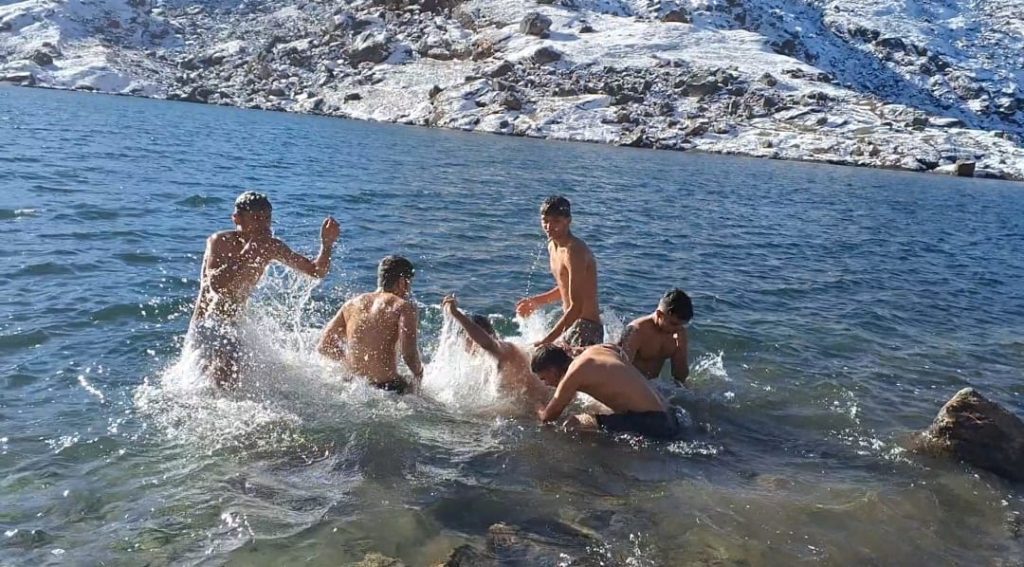
Afterward, we rushed back to the lodge for a hot cup of tea, wrapped ourselves in blankets, and just started laughing with no reason. The lake, the mountains, the freezing water, all of it felt something so raw and pure.
Gosaikunda trekking is truly one of the best trekking experiences in Nepal. The combination of rugged trails, untouched landscapes, and cultural richness makes it unique trekking trails than other places. It’s more than just a physical journey; it’s more likely an emotional and spiritual journey. If you’re planning to experience trekking in Nepal, Gosaikunda Lake located at Langtang region is enough for the needed challenges and rewards that last a lifetime. As I sit here writing this, I can still feel the cold air and hear the sound of our laughter. Gosaikunda is a place that will stay forever with me.
2023
Nepal Travel Guide
Nepal Travel Guide for tourists interested in traveling to Nepal. This article includes information to be considered before traveling to Nepal.
Traveling in Nepal will be a definite adventure for travel enthusiasts around the world. Whether it is a few short days for a sightseeing tour or a long trekking adventure into the grand Himalayas. Traveling, in general, will be an exciting adventure for everyone – no matter what their current age, nationality, or physical capabilities. There’s everything for everyone in Nepal. From the Southern Terai belt with lush green jungles filled with exotic wild animals, to the thrilling landscapes of snow-capped landscapes in the northern territories of Nepal.
What to expect during the Nepal Trip?
Nepal has its own unique, beautiful, fascinating history and culture that can simply overwhelm you with a feeling of enchantment. The entire region of Nepal is full of diversity. No matter where you go, there will always be something new and fresh waiting for you. Hence, I can proudly claim that you will never be bored during your travel days in Nepal. With incredibly fun and friendly local people, travelers can enjoy a relaxing travel experience in Nepal. Without worrying about a place to sleep for the night as there are technically numerous teahouses and lodges inside the trekking trails.
Things to do before Traveling to Nepal
However, you do have to consider some extra measures before flying off to Nepal, including some Nepal Travel Guides. First and foremost, as a traveler who simply wants to come, explore, and return without any sort of complications, you have to do proper documentation of the country you are traveling to. Meaning, you have to get a legally approved Passport and Nepalese Visa which might not take you much time. After that, you have to consider the things which you are planning to take with you during your traveling. Keep your packing list short. Don’t override it with nonsense stuff that might not come in handy while you stay in Nepal.
In addition to that, you need to keep in mind that, many of the things needed for your journey will be available in Nepal. The place where you plan on staying which might be Thamel will have all the needed fancy shops and markets for you to buy clothes and equipment. Next, you have to get a hand with the right trekking permits if you are planning to go on a trek. Otherwise, that’s not necessary at all. If you wish to go for some paragliding or rafting, then sure just get in touch with a legal tour operator and they will handle the rest for you. Of course, you have to go and do some dealings with them but you will eventually have your part of the deal.
Travel Insurance | Nepal Travel Guide
Last, of all, you simply can’t forget to take care of your health while traveling. You have to focus on what you are eating before embarking on trekking activities. Especially if you have any suspicion about the quality of the food. In addition to that, you must consider hiring a guide for a trek to some isolated rural regions of Nepal. But before these things, you have to get yourself dependable travel insurance. The insurance shall cover your expenses/losses that can occur while traveling. You might have to rescue due to injury or something else and it can take helicopters to do so, which is pretty expensive. Therefore, have your travel insurance with you before coming to Nepal.
2022
During a trek in Nepal, what food should you expect?
Expect authentic food during the trek to Nepal. Nepal’s diversified population includes people from many cast, religions, and cultures, which is highly fascinating. Ever since the community was unified, there has been peace. Every distinctive commune has its own style of living and distinct and unique cuisine. You can definitely keep your belly satisfied for a while by munching on some light crumbs. However, your body will soon be craving meals after long hours of strenuous trekking through the rugged terrain.
There are a whole lot of options that you can choose from to fulfill your hungry belly. Fast food, such as pizza and burgers, is also available on the menu. In addition to fast cuisine, you can relish an outburst of authentic flavor that will astound you.
What food to really expect during treks?
Expectations shouldn’t be too high because the food served on walking trails is typically not fancy. Yet even the most basic foods will surprise you. The locals will prepare with all their love and serve you with the best hospitality. For a moment you will feel that you are back home enjoying your meal. Let me introduce you to some of the basic food eaten during the treks.
Breakfast
Breakfast without a doubt is the most important meal of the day. The Tibetan flatbread will definitely please your empty tummy. You can eat it with an omelet or else if you have a sweet tooth it tastes better with honey as well. However, the breakfast choice is not limited, you can choose from a different variety from the menu.
Lunch
“MoMo” is another genuine dish you can enjoy for lunch (A dumpling stuffed with savory meat filling served with achar). You can choose French fries as a side dish, but limit how much you eat because too much of it will make it difficult to hike.
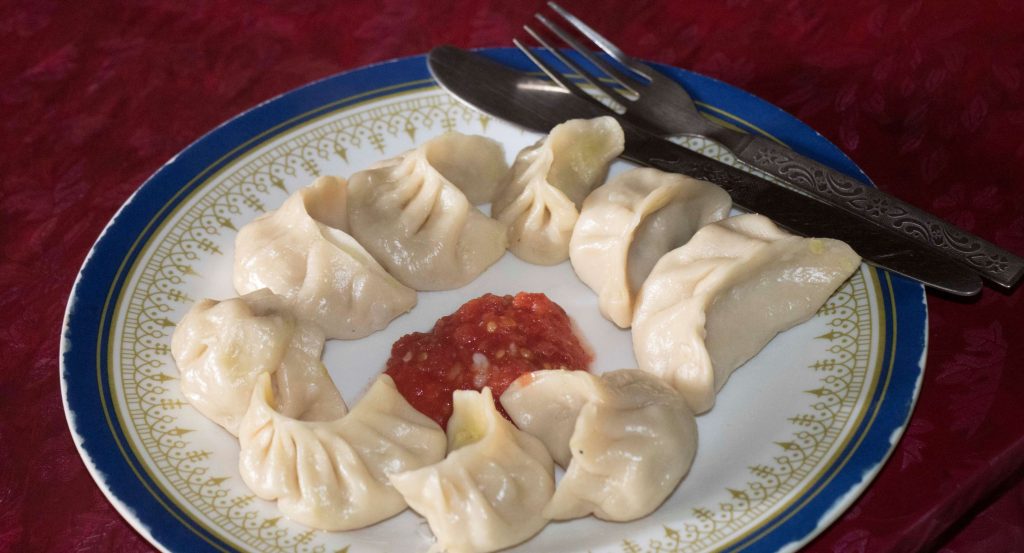
Dinner
You will be familiar with the expression “Daal-Bhat power 24 hours” by the time you have walked for one or two days. It is a staple of the common Nepali diet. The majority of Nepalis consume it twice daily, which offers them the energy they need for work. Dal Bhat, which consists of rice, lentil soup curries (vegetable or meat), and a flavorful pickle that will undoubtedly tickle your taste bud.
Dhido, a meal made by gradually adding flour to boiling water and combining it until the result is stiff, is another food that will surprise you. Make a small ball with one’s finger, dip it in (lentil soup, meat soup, gundruk) and eat it without swallowing. It tastes better with chutney!
Here are only a few of the typical staple foods. Don’t miss the chance to discover and expect authentic food from a diverse Nepalese community while you are in Kathmandu.
Sneha Dongol
2022
Trekking in Winter?
Trekking in winter may sound absurd. Traveling in winter is surely challenging for many of us. Many travelers are out there exploring the snow-capped mountain summits, meanwhile, the chilly weather sets in, and the majority of us remain snug in our beds. How thrilling is it to step outside of your comfort zone and carry out something entirely different? It sounds insane but also overwhelming. You will undoubtedly feel empowered after completing a trek because it’s a huge accomplishment.
In Nepal, the winter season begins in December and often lasts through mid-late February. It is possible for the temperature to fall below 0 degrees Celsius and occasionally even lower. This is typically the time of year when snow falls in the mountainous area. The wonderful scenic vistas are presumably what the tourists wish to see throughout the journey, but regrettably, the visibility of such views is very low in the winter season. Despite all the challenges, the traveler has a wide variety of choices from which to choose and begin their trek. With the proper gear, equipment and guidance there is nothing that is achievable. Since there are many short hiking paths in Nepal, allow us to thoroughly walk you through a few of them.
Ghorepani- Poonhill Trek
The Poonhill Trek, one of the easiest hikes that may be completed during the winter season easily, will probably cover the Annapurna Sanctuary. Better teahouses and guesthouses can be found along the Poonhill Trek path, which is well-routed. The walk can be completed without a guide because of its modest level of difficulty.
The 4- to 5-day Ghorepani-Poonhill walk begins with a flight from Kathmandu to Pokhara, followed by a Starting from Nayapul, we go on our trek. We arrive at an elevation of 1480 meters, which will allow us to spend the night in Tikhedhunga, and the main attractions of this hike can be the beautiful landscapes. The following day, we will hike from Tikheydhunga to Ghorepani, reaching a height of 2860 meters. The next morning, we will be hiking to Poonhill which will roughly take 45 minutes to endure the sunrise along with the panoramic view of Annapurna, Dhaulagiri, and Manaslu ranges. After spending some time, we reach back to Ghorepani for breakfast and thereafter hike 5-6 hours to Tadhapani. The next morning, we trek to Ghandruk, have lunch there and explore the beautiful Gurung village and head back to Pokhara.
Mardi Himal Trek
Another pristine yet easy trek that anyone can do is Mardi Himal Trek. This trek will primarily cover the Annapurna region. Usually, the journey takes five days to complete. Although it is possible to complete the walk with some assistance, the difficulty level is more likely to be severe during the winter.
We take a flight/ private vehicle or tourist bus from Kathmandu to Pokhara, then drive to Kande, where we begin our trek. After hiking for roughly 5 to 6 hours on this particular day, we reach Pitan Deurali (2100m) via Australian Base Camp (2060m). We hike the next day at the same pace, which will take us to Low Camp (2985m). From thereon, the next destination will be High Camp (3550m)which will take about 3-4 hours of hike. The fourth day will most probably be the longest hours of walking as we reach Mardi Base Camp (4500m). Take time in the mesmerizing mountain-top, and then have lunch and hike back to Badal Danda. Overnight at lodge. On the final day, we have breakfast and walk our way through Siding, which takes about 4 hours of trekking. After lunch, we drive to Pokhara and night stay at the hotel.
Ghandruk Trek
Ghandruk treks often cover the Gurung community in the Annapurna region, where guest-friendly atmosphere hospitality services are basically provided. As you stroll around, you may observe the variety of flora and animals, which adds to the area’s beauty. This location’s vibrant culture is another distinctive aspect that shouldn’t be missed.
The majority of the four-day Ghandruk trek is moderate in difficulty, and it’s also quite an interesting one. After arriving in Kathmandu, we take a private bus, aircraft, or tourist bus to Pokhara and take a jeep to get to Nayapul (1070m). On this day, we trek toward Ghandruk, our destination for the day’s end. As we move along, we pass stunning landscapes like Hiunchuli, the Annapurna South, and the fishtail. The next day, we walk at the same pace and ascend to Landruk Village (1,545 m), from which the trail pleasantly climbs to Tolkha. Following the Bherikharka trails, the climb to Deurali is difficult (2,100m). Spend the night in Tolkha. We leave Tolkhe and travel to the Gurung-dominated settlement of Dhampus, where we spend the night. On the last day of the trek, we head to Phedi which will roughly take us 2-3 hours, and return back to Kathmandu.
Chisapani Nagarkot Trekking
The Chisapani Nagarkot trek is yet another short one. The distance between Nagarkot and Kathmandu is only about 29 km, making it a convenient location for both a night’s rest and exciting excursions. Views over the Kathmandu valley and Shivapuri National Park allow visitors to see all of the mountain ranges, including the Annapurna, Manaslu, Ganesh Himal, Langtang, Jugal, Rolwaling, and Mahalangur ranges.
Upon your arrival in Kathmandu, one of our representatives will meet you at the airport. After lunch, we can visit Basantapur Durbar Square, a World Heritage Site, to learn more about the local way of life and culture. The following day, we go by private vehicle for an hour to Sunjarijal, where our hike begins. Starting from here, we gradually walk through the stone steps of Sundarijal, passing by a beautiful waterfall, and a temple before entering the Shivapuri National Park. The following day, we get ready for our journey, make our way gradually toward Nagarkot, and halt at Jule. Following that, we gradually climb to Nagarkot’s hilltop, which is famed for its breathtaking sunrises and sunsets. We can enjoy the sunset with some light refreshments once we arrive. On the last day, we take a detour to Changunarayan, another World Heritage Site on our way back.
Sikles Trek
The Sikles trek begins as we travel from Kathmandu to the picturesque, blessed-with-nature city of Pokhara. From there, we take a short drive to Milan Chowk and begin our climb toward Kharpani. At Kharpani, we can immerse ourselves in warm water and take use of a natural hot spring. We continue our trek through Parche, a stunninglocaldlish Gurung village, Ghalegaun, and finally Sikles. Here, at an elevation of about 2,000 meters, we have fantastic views of Lamjung Himal and Annapurna. At Sikles, we investigate the Gurung communities’ customs, culture, and way of life. How do they conduct their daily lives and observe their festivals? How do they participate in the production of regional crafts? A highly interesting and enjoyable hobby would be experiencing and learning all of these things.
Sneha Dongol
2021
Light of hope on Nepal Tourism with On-Arrival VISA and Quarantine Removal
Thursday, 23rd Sept 2021, The Government of Nepal has finally announced a piece of hopeful and consoling news which we travel agents and the travel enthusiast interested to travel in Nepal have been waiting for a long time. Finally, after a long wait, the mandatory quarantine rule of 10 days after arrival in Kathmandu is relaxed and thrown away. Along with that, the concerned authorities have also declared to resume providing the On-Arrival Visa to the travelers which were restricted since the pandemic began. Prior to this official notice, the travelers were obliged to get their entry permits from the respective Nepali diplomatic missions, and also stay in a mandatory 10 days quarantine in the government-listed hotels.
However, the easing of these strict restrictions does not imply to all the travelers. It is valid for only those travelers who have already received the full dosages of the vaccination against Covid, at least 14 days before their travel dates. The travelers who are not vaccinated or partially vaccinated are not able to get the on-arrival VISA and still follow the previous guidelines for getting the Visa.
While on the other hand, there are still certain rules and regulations which are implied upon the travelers despite being vaccinated.
The updated rules to be practiced by the vaccinated tourist are as follows:
- The vaccination card proving the completion of at 14 days of receiving the final dosages of vaccination.
(We recommend you to have a photocopy or QR code of the same for your ease.) - PCR Test Negative report, at least 48 hours prior to check-in date to the immigration.
- The photocopy of trekking and mountaineering permits.
- The proof of hotel booking in Nepal.
- A printed copy of the International Traveler Form submission that the travelers shall fill up by logging into the CCMC website (https://ccmc.gov.np/).
(Note: After submitting the form, a System Generated Bar Code is displayed, please take a screenshot (Win + PrtSc) or print it and keep it safely. If any error occurs or you shall make any corrections after the form submission, you can click on correction support) - The foreign tourists shall have a travel insurance which covers all the expenses related with travel as well as Covid-19.
The updated rules to be practiced by the non-vaccinated tourist are as follows:
- The foreign tourists who are not vaccinated or partially vaccinated shall go for Antigen Test (RT-PCR or Gene Expert or True NAAT) at the Immigration Check-In point after arrival in Nepal and if the test report is positive, the foreign tourists are bound to stay in a 10 days quarantine in the hotel on their own expenses. On the 11th day, if the Covid-19 test report is negative, the foreign tourists are allowed to embark on their desired trek/tour.
- The foreign tourists shall be liable of the expenses that occurs during their stay in isolation, the travel insurance and other miscellaneous expenses.
- All foreign tourists who are traveling in Nepal and having any sign or symptoms of Covid shall immediately go for the test and in case if the test report is positive then s/he shall stay in isolation.
- The concerned agencies are responsible to make the tourists follow these rules and regulations to those foreign tourists who are traveling in Nepal through travel and trekking agency.
- The concerned hotels are responsible to make the tourists follow these rules and regulations to those foreign tourists who are staying in quarantine or isolation in the hotel.
- If the foreign tourists are not following these rules and regulations then the concerned travel agency or hotel shall inform Nepal police or other concerned authorities regarding the same.
For more details: https://www.tourism.gov.np/files/NOTICE%20MANAGER_FILES/Travel%20Advisory%20Aadesh078%20to%20Upload.pdf
Ultimately, the disrupted travel and tourism industry of Nepal is getting light of hope for recovery and reviving. While the streets of Kathmandu and the trekking and mountaineering trails should have been full of tourists in this season, there are scarcely a few foreign tourists in the Nepali territory because of the pandemic and travel restrictions. Now, with the easing of the On-arrival Visa procedure and removal of the quarantine rule, travel lovers could visit Nepal without any hassle from September 2021 onwards. After a long hectic and exhausting period of more than 2 years, the nature and travel lovers are able to explore the untouched beauty of Nepal and we at Nepal Mountain Trekkers are keenly waiting to welcome all the travel enthusiasts to Nepal for a relaxing, revitalizing, and remarkable experience of a lifetime.
Thank you for reading the post and if you would like to explore travel and tours packages in Nepal, you can browse through our web portal: localdlish.com or directly contact us via email. And, we would love to hear your feedback and suggestion regarding this post. Have a wonderful time ahead!
2021
Why travelling is important for your health?
The hectic life, busy schedule, loads of work, pressure and pressure, and pressure.
Are you tired of your everyday lifestyle and facing difficulties in handling stress? Well, the best and ultimate natural solution to handle this kind of depressive feeling is to travel and explore.
What does research say about Traveling?
According to research, travel lowers your stress and helps to improve productivity at work. As well as traveling helps to reduce the risk of heart disease and many other diseases. Whereas you’ll be fit and fine physically as well as mentally if you frequently travel.
Well, traveling is the best way to explore more about nature, history, culture, lifestyle, foods, and many more. But apart from that, it is very important and necessary for your health as well. While you travel, you’ll learn a lot of things. You’ll get refreshment and of course, physical exercise as well which will help you to stay away from negative vibes and achieve positive vibes which is the most essential thing for every individual.
Types of Travelers and their Purposes
Some people take traveling as a passion or hobby and some are compelled to travel whereas some travel as a requirement of their profession. Whatever the reason is humans are meant to travel. To explore, discover, and catch positivity from around the world and maintain a balanced lifestyle.
If you don’t travel and stay bound within a place then it’s obvious that your knowledge and ideas will be limited. You will be stressed and it may lead to negative thoughts and all that. Along with that, your physical health won’t get a chance to get refreshments and adequate exercise. So, traveling is very important for every person, depending on available time and ability to travel.
Everyone needs some time on their own or with their dearest ones, far from the crowd and hectic lifestyle to enjoy the freedom and the real meaning of life, or maybe to get some peace. If you love to explore lifestyle and culture and things related to it, you can travel to different places and spend your time doing what you love to do.
Travel Plans in Nepal: The Himalayan Nation with Diverse Culture
If you love nature, you can travel to the Himalayas, enjoy mountain sceneries, inhale fresh air, and get the feeling of peace of mind. Likewise, there is a variety of options to choose from according to the nature of the traveler to travel and fulfill their desire. You just need to contact us (Nepal Mountain Trekkers) and let us know your requirements. And then we will be providing you with the best options.
Nepal Mountain Trekkers is a trekking company operated by highly dedicated and experienced staff and we possess a deep understanding of all the tourist destinations in Nepal. Well, you will get the feeling of lifetime achievement, adventure excitement, and endless joy while traveling with us. We assure you about that. So, don’t think much and avoid all the negative vibes. We’ll make the best and memorable trip for you and you’ll surely enjoy it. When you return, you’ll clear all the stress and frustration, putting a smile on your face, lifetime memories in your heart and brain, and an amazing friendship with our team.
You can visit our official website:
www.nepalmountaintrekkers.com or www.nmtrekkers.com
Or write us an email at info@nepalmountaintrekkers.com
Thank you!
